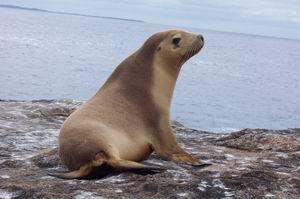
The Australian sea lion population decreased due to harvests in the 17th and 18th centuries and traditional subsistence hunting by aborigines (Goldsworhty & Gales 2008). Isolated reports of deliberate killings have persisted into the 21st century as well (DEWHA 2010). Although the species is now protected by Australian law throughout its range, recovery towards pre-sealing levels has been minimal (Goldsworthy and Gales 2008; AFMA 2010). Currently, the biggest threat facing the Australian sea lion is bycatch mortality, primarily in demersel gillnets set to catch sharks, and in rock lobster pots (Goldsworthy & Gales 2008; Shaughnessey et al 2003; AFMA 2010; Goldsworthy et al 2010). According to a 2010 comprehensive report on pinniped-fishery interactions in Australia, most subpopulations of Australian sea lion are subject to unsustainable levels of bycatch mortality (Goldsworthy et al 2010). Exacerbating the problem are several unique species characteristics - minimal dispersal, extreme female site fidelity, small breeding colonies, asynchronous breeding season - that contribute to the decreased ability of the Australian sea lion to recover from mortality events (DEWHA 2010). It is believed that removals of only a few individuals due to bycatch could cause certain sea lion colonies, especially those on the smaller side, to go extinct (DEWHA 2010).
The near-perfect spatial overlap between Australian sea lion foraging areas and areas utilized by gillnet fishermen targeting sharks (Goldsworthy & Page 2007) results in the death of ~374 animals per breed cycle (17.5 months) due to bycatch (Goldsworthy et al 2010). This mortality occurs despite a 60% reduction over the past two decades in the amount of gillnets set annually near sea lion colonies, and a 27% reduction in the number of gillnet boats operating in South Australia in 2005 (AMFA 2010). In 2007 - 2009, the overall bycatch rate in south and eastern Australia was estimated at 4.25% (Goldsworthy et al 2010). In 2012, the Australian Fisheries Management Authority (AFMA) revised its definition of a sustainable bycatch level from 1.5% of the female breeding population (52 animals per breeding cycle) to 15 females taken as bycatch per year (AMFA 2012).
In addition to gillnet bycatch mortality, Australian sea lions are attracted to the bait in rock lobster pots, leading to rope entanglement and drowning of pups and juvenile animals, which cannot escape from the pots once inside (Gales et al 1994; Shaughnessey et al 2003; Campbell 2004; Goldsworthy et al 2010). Adding sea lion exclusion devices, such as spikes, to the opening of the pots significantly reduces this type of bycatch mortality. It has been shown that the ability of sea lions to enter rock lobster pots decreases in response to increasing spike height (Goldsworthy et al 2010).
Marine debris from fishing operations poses a threat to the Australian sea lion population as well, with monofilament gillnetting being the greatest hazard (Page et al 2004). In one bay in South Australia, 0.1-1.3% of the population was determined to be entangled - the third highest entanglement rate ever recorded in any pinniped species (Page et al 2004). Approximately 54% of entangled animals were pups, and it was expected that at least 43% of sea lions overall died as a result of injuries sustained due to entanglement (Page et al 2004). It is probable that the actual mortality rate of sea lions is higher, as entangled animals are likely to die unobserved at sea (Page et al 2004).
Mitigation measures in place include (1) mandated time-area closures, (2) voluntary closures of fisheries operating within 4 nautical miles of sea lion colonies in South Australia, (3) restrictions on gillnet type and mesh size, and (4) the establishment of "trigger" mortality levels that result in fishery closures when reached (AFMA 2010). Moreover, AFMA has plans to conduct trials using underwater net-monitoring cameras, colored gillnets, weaker gillnets, and sea lion deterrent devices (AFMA 2010). AFMA is also investigating the possibility of switching to hook-and-line fishing, although the economic consequences and potentially detrimental impacts on targeted species may render this option unfeasible (AFMA 2010).
References
Australian Fisheries Management Authority (AMFA). 2010. Australian sea lion management strategy: Southern and eastern scalefish and shark fishery. AFMA, Canberra, Australia.
Australian Fisheries Management Authority (AFMA). 2012. Australian sea lion bycatch triggers- changes to fisheries management arrangements to further protect Australian sea lion sub-populations in the gillnet, hook and trap fishery. AFMA, Canberra, Australia.
Department of the Environment, Water, Heritage, and the Arts (DEWHA). 2010. Draft recovery plan for the Australian sea lion (Neophoca cinerea). Commonwealth of Australia, Barton, Australia.
Campbell, R. 2004. Report for the Sea Lion Scientific Reference Group. Fisheries Occasional Paper No. 16. Department of Fisheries, Government of Western Australia. 20 pp.
Gales, NJ, PD Shaughnessey & TE Dennis. 1994. Distribution, abundance and breeding cycle of the Australia sea lion Neophoca cinerea (Mammalia: Pinnipedia). Journal of Zoology 234: 563-570.
Gales, NJ & SD Goldsworthy (IUCN Pinniped Specialist Group). 2008. Neophoca cinerea. In: IUCN 2012. IUCN Red List of Threatened Species. Version 2012.2 Accessed 6 December 2012. www.iucnredlist.org
Goldsworthy, SD & B Page. 2007. A risk-assessment approach to evaluating the significance of seal bycatch in two Australian fisheries. Biological Conservation 139: 269-285.
Goldsworthy, SD, B Page, PD Shaughnessey, & A Linnane. 2010. Mitigating seal interactions in the SRLF and the gillnet section SESSF in South Australia. SARDI Aquatic Sciences Publication No. F2009/000613-1. SARDI Research Report Series No. 45.
Page, B, J McKenzie, R McIntosh, A Baylis, A Morrissey, N Calvery, T Haase, M Berries, D Dowie, PD Shaughnessey & SD Goldsworthy. 2004. Entanglement of Australian sea lions and New Zealand fur seals in lost fishing gear and other marine debris before and after government and industry attempts to reduce the problem. Marine Pollution Bulletin 49: 33-42.
Shaughnessey, P, R Kirkwood, M Cawthron, & D Pemberton. 2003. Pinnipeds, cetaceans, and fisheries in Australia: a review of operational interactions. In: N Gales, M Hindell & R Kirkwood (eds), Marine mammals, fisheries, tourism and management issues. pp. 136-153. CSIRO Publishing, Collingwood, Australia.
